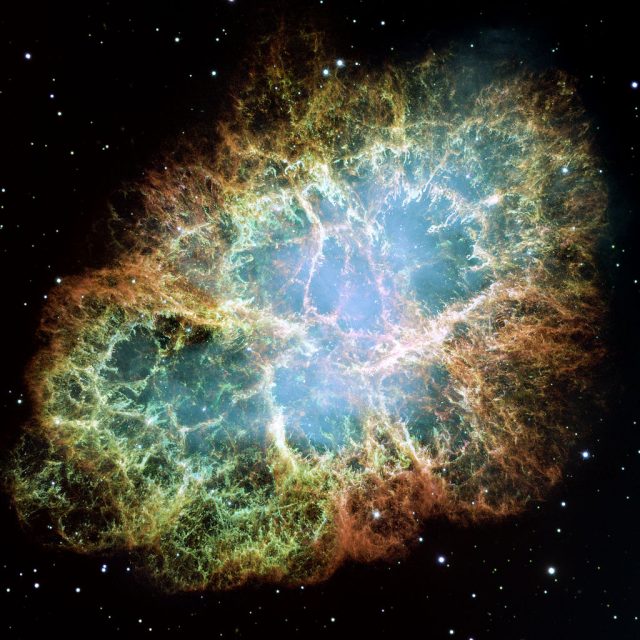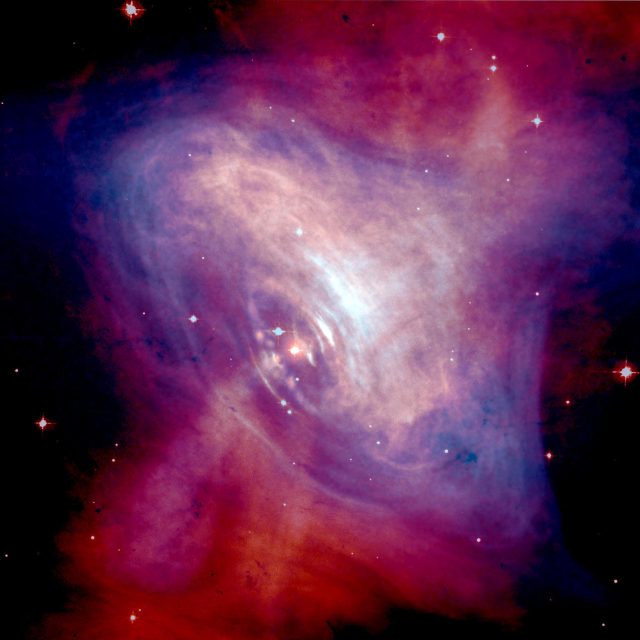Of crabs and men
Time scales for astrophysical phenomena are sometimes thought to be overwhelmingly large and to exceed by far human life. While this is true for many cases, there are others which take the blink of an eye. Halfway between them, some interesting facts seem to happen in historical time scales and therefore have been analyzed by human beings with changing eyes. The evolution of thinking is then projected onto them and history and science become intertwined.
One of the most beautiful cases is that of the Crab Nebula and its associated pulsar. A very recent work by Andrew Lyne and collaborators in Science magazine has shown its evolution in the last 20 years, suggestive of things happening on its interior almost right now 1. The Crab Nebula is the first of Charles Messier’s catalog, therefore usually called M1. Quite ironically, the first object in the French astronomer’s list was of a different nature than any of the others. In any case, the goal of his catalog was simply to avoid targets potentially mistaken by comets, particularly for the quest of the Comet Halley in the XVII century. It was assumed for many decades that it was a ‘normal’ emission nebula and even John Herschel thought to see individual stars embedded in the bright nebula 2. Not quite, actually.

By 1921, J.C. Duncan and C.O. Lampland reported changes in M1 in the Proceedings of the National Academy of Sciences and those of the Astronomical Society of the Pacific, respectively. The astonishingly large expansion velocities inferred from their works required the nature of the nebula to be revised. It was easy to rewind and conclude that by year 1,000 AC the object should have been squeezed to a stellar size. This meant that the nebula was in fact a supernova remnant and, being located at some 6,500 light-years, the explosion could potentially had been observed by human eyes. It was. Chinese astronomers reported the presence of a ‘guest star’ in the sky by 4 July 1054, lasting for two years and reaching an impressive luminosity. Its position close to the Sun at peak magnitude made it difficult to be observed during daylight and this prevented other civilizations to spot it.
At the present moment, astronomers have identified inside the Crab Nebula a radio source (3C144), an intense X-ray source (Taurus X-19) and a pulsar (PSR 0531+21). All correspond to the same object, the core of the exploded star, rotating every 30 milliseconds 3. This pulsar is extremely important for scientists, since it is very young and very close to us. And this makes it possible to careful analyze its rotation, as the work by Lyne et al. reports. This work uses observations taken daily during 22 years with the 13-m radiotelescope at Jodrell Bank Observatory and less-frequently with Lovell Telescope, roughly six times bigger.

The two decades of observation of the pulsar has provided good clues on the behavior and evolution of young pulsars. As shown in the figure 3, the pulsar displays not a single pulse but two components with slightly different phases. These signals are originated in the magnetosphere of the neutron star, where the magnetic field lines that close within the light cylinder meet with those open and nearer to the magnetic poles. The most important result of this work is the discovery of the components drifting apart in phase from each other. But, what does this mean?

Since these radio components are also observed and closely match high-energy emissions, it is possible to us models of such X-ray sources to discuss the observations. In short, those emissions come from a cone tilted with respect to the rotation axis of the star. If we assume that the pulsar is not behaving very differently from others, the simplest explanation to the observed change in the radio emissions is that the angle of the emission with respect to the rotation axis is also increasing with time, at a rate of 0.62º per century, and approaching orthogonality. If the magnetic field were a simple dipole then an evolution to alignment and not orthogonality would be more likely. However, this can be interpreted as the a torque over the magnetic field being developed by the return current in the surface of the quickly spinning neutron star. This torque would have produced a change of 6º since the pulsar was born. As the authors point out at the end of the paper “It is unlikely that comparable measurements can be made on any other pulsar in the near future”, and this makes this work particularly relevant.
So, since the Chinese astronomers peeked into the guest star in the heavens at the beginning of the second millennium to the radio astronomers revealing the incredible forces in the very center of the dead star, we have witnessed the evolution of the human thinking as well as the evolution of the star itself. Our thoughts and theories evolve, as nature does. And this hopefully means that we are reaching a more precise understanding of the Universe and that the years to come will bring ideas and facts that now we can only wonder.
References
- Lyne A., Graham-Smith F., Weltevrede P., Jordan C., Stappers B., Bassa C. & Kramer M. (2013). Evolution of the Magnetic Field Structure of the Crab Pulsar, Science, 342 (6158) 598-601. DOI: 10.1126/science.1243254 ↩
- J.L. Comellas (1995). Catálogo Messier. Madrid (Spain), Editorial Equipo Sirius. ISBN: 84-86639-76-X ↩
- COMELLA J.M., CRAFT H.D., LOVELACE R.V.E., SUTTON J.M. & TYLER G.L. (1969). Crab Nebula Pulsar NP 0532, Nature, 221 (5179) 453-454. DOI: 10.1038/221453a0 ↩
2 comments
[…] en el cielo… durante varios meses y de aquellos polvos… estos remanentes… La estrella en su interior, convertida en un potente púlsar, sigue emitiendo grandes cantidades de energía (rayos gamma, […]
[…] [Leer la entrada en Mapping Ignorance] […]